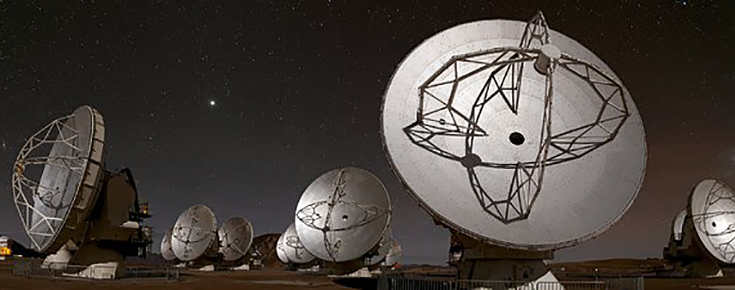
Sean Dougherty, diretor do Observatório ALMA, encontra-se de visita ao Centro Português de Competências para o ALMA (PACE) e realizará um seminário extraordinário em Ciências ULisboa, inserido no ciclo de seminários do Departamento de Física.
O PACE é uma estrutura do Instituto de Astrofísica e Ciências do Espaço, unidade de investigação da Faculdade de Ciências, que presta apoio ao ALMA e aos seus utilizadores em Portugal, integrando o ALMA Regional Centre Europeu que é coordenado pelo Observatório Europeu do Sul.
The Atacama Large Millimeter Array (ALMA) located at 5000m altitude in northern Chile is an extraordinary achievement of innovation and construction. This talk will introduce briefly the ALMA telescope system and the remote, high-altitude site, provide a report on the current status of the telescope, and describe some of the ground-breaking results that have been produced over the first five years of operation. Looking to the future of the telescope, the development plans for the next decade set out in the Development Roadmap will also be described.
Bio: Sean Dougherty is currently the Director of the ALMA Observatory, the world’s foremost millimeter/submillimeter interferometer array located at 5000m altitude in the Atacama desert in northern Chile. Previously he was Director at the Dominion Radio Astrophysical Observatory, Canada's national radio astronomy facility and part of the National Research Council's Herzberg Institute for Astrophysics. There he managed NRC’s work on the design of the SKA-mid correlator, and managed the production, installation and commissioning of the WIDAR correlator for the Jansky VLA in New Mexico, USA. He has served on a science and engineering advisory committees for a number of projects including the SKA and the ngVLA. He is currently the chair of the ASTRON Science Advisory Committee and a member of both the Smithsonian Millimeter Array Advisory Committee and the MPIfR advisory committee. His research interests are related to the circumstellar environments of massive stars, using observations from gamma-ray energies to radio wavelengths, but he is a specialist in radio interferometry.

